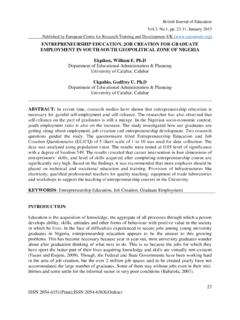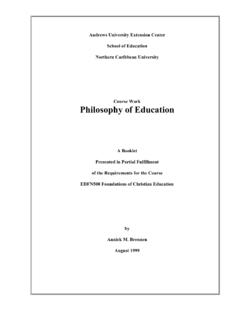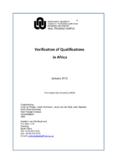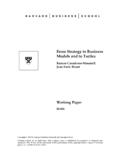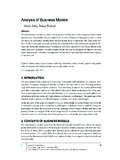Transcription of Country situation and role of agriculture il 1 Z ra B
1 Country fact sheet on food and agriculture policy trends | April 2014. Country situation and role of agriculture BRAZIL. The Federative Republic of Brazil is the largest Country in the Latin American region and the fifth largest Country in the world in terms of both geographical area and population. In 2012, Brazil was the world's seventh largest economy, having a GDP per capita of US$ 11 340, thus being classified as an upper-middle income Brazil is a major player in global agricultural trade, accounting for percent of global agricultural exports. It is the world's third-largest exporter of agricultural products, behind only the EU and the United States. Soybean products remain the largest export, followed by sugarcane products (sugar and ethanol), meat (especially poultry and beef), coffee and cereals.
2 The agricultural sector, being vital to Brazil's economic and social development, is supported by two separate ministries: the Ministry of agriculture , Livestock and Food Supply (MAPA), focused primarily on agribusiness development and market integration; and the Ministry of Agrarian Development (MDA), created in 1999 to establish land reform, promote sustainable development and support family farming. According to the 2006 Agricultural Census, family farm establishments represent 84 percent of the Country 's farms and contribute 38 percent to the gross value of agricultural production. The government has been pursuing an integrated strategy of growth with social inclusion, involving Ministries of Social Development, Education and Health among others.
3 Significant improvements in the reduction of poverty and inequality have been achieved; inequality has fallen to as measured by the Gini index, the lowest level in 50 Furthermore, Policy Decision Analysis as of 2012, Brazil's Human Development Index (HDI) was , having increased by 40 percent from Food and agriculture Selected indicators 2007 2009 2012. GDP (current billion US$) * 1 367 1 620 2 252. GDP per capita (US$) * 7 194 8 373 11 340. SOCIO-ECONOMIC. Agricultural value added (% of GDP) * 6 6 5. Agricultural value added (annual % (average 2007-2012) growth) * (2012) Total population (thousand) 189 997 193 491 198 656. Rural population (% of total) Agricultural labour force (% of total labour force) Human Development Index ** (2012) (ranking 85).
4 Per capita cultivated land (ha) NA Area equipped for irrigation (ha) 5 400. AGRICULTURAL PRODUCTION & TRADE. Value of total agriculture production (current million US$) 108 391 129 670 NA. Value of cereals production (current million US$) 12 873 13 569 NA. Yield for cereals (hg/ha) 35 531 35 315 45 845. Cereal import dependency ratio (%) (2007-2009) - Net imp Top 3 commodities Production quantity Sugar cane, Soybeans, Maize Production value Meat indigenous, Cattle, Sugar cane, Soybeans Import quantity Wheat, Malt, Flour of Wheat Import value Wheat, Rubber Nat Dry, Malt Export quantity Soybeans, Sugar Raq Centrifugal, Cake of Soybeans Export value Soybeans, Sugar Raw Centrifugal, Coffee, Green Top 3 trade partners Import value Argentina, Indonesia, Uruguay Export value China, mainland, Netherlands Top 3 commodities available for consumption Sugar (Raw Equivalent), Wheat, Rice (Milled Equivalent).
5 Per capita food supply (kcal/capita/day) 3 110 3 173 NA. FOOD SECURITY & NUTRITION. General (g) and Food (f) CPI (2000=100) (g), (f) (g), (f) 214 (g), (f). People undernourished (million) (2008-2010) (2011-2013) Proportion of undernourished (%) (2008-2010) (2011-2013) Prevalence of underweight children under 5 years of age (%) NA NA. Prevalence of stunting among children under 5 years of age (%) NA NA. Prevalence of wasting among children under 5 years of age (%) NA NA. Global Hunger Index ^ (2013) <5. Access to improved water sources (% of population) * 96 97 NA. Source: FAOSTAT; *Source: WB; **Source: UNDP; ^ Source: IFPRI. This activity is funded (accessed on 20 March 2014). by the European Union under the Improved Global 1 Data available at: , accessed on 20 March 2014.
6 Governance for Hunger Reduction 2 OECD 2013, Agricultural Policy Monitoring and Evaluation 2013, OECD Countries and Emerging Economies Brazil, available at: Programme tural- 3 The HDI measures national development through health, education and income levels. Data available at: , accessed on 20 March 2014. 2 FAPDA Country fact sheet on food and agriculture policy trends | BRAZIL. 1. Government objectives in agriculture , food and nutrition security Main strategies, policies and plans related to agriculture adopted Main strategies, policies and plans related to Food and Nutrition by the government during the period 2007-2013 are the Security (FNS): following: i. Zero Hunger Strategy (Fome Zero), 2003. This is the i. Multi-annual plan 2008-2011 of the Ministry of government's main policy for guaranteeing the right to food agriculture , Livestock and Food Supply (MAPA).
7 The for the population. It aims at combating extreme poverty and plan promotes sustainable development and competitiveness inequality in Brazil through integrated measures of expanding of agribusiness 4 for the benefit of Brazilian society, with access to food, income generation, productive inclusion, integrated programmes intended for small, medium and education and health programmes. large-scale farmers. The aim is to develop agribusiness in an ii. Brazil Without Misery Plan (BSM), 2011. The objective of economically, socially and environmentally sustainable manner. this plan is to eradicate extreme poverty in Brazil by 2014, ii. Family Farming Harvest Plan, 2002/2003 onwards. through productive inclusion, income security and access to Every year since 2002, the Ministry of Agrarian Development public services for the whole population.
8 (MDA) implements its annual plan in support of the sector iii. National Policy for Food and Nutrition Security (PNSAN), with the objective of increasing innovation and technology 2006. Food security and nutrition (FSN) are identified as and of stimulating food production, together with income a strategic objective to be pursued with permanent and protection. To this end, the various plans have enhanced a intersectoral public actions and policies, guided by the set of public policies which put family farming as a pillar for principles of food sovereignty and the human right to national development (see producer-oriented policies below), adequate food. together with continued technical assistance and extension. 2. Trends in key policy decisions (2007 to 2013).
9 Agricultural Producer Support Programme (PRONAMP) and the Producer-oriented policy decisions Low Carbon agriculture Programme (see concluding remarks). State support to production has been strong during the review financed rural activities of micro, small and medium farmers period and accompanied all stages of the production cycle, with by subsidizing credit with the aim of increasing income and the primary aim of increasing farmers' productivity and ensuring employment generation in agriculture . The main institution food security. The government's priorities from2007 to 2013 providing rural credit at subsidized rates or acting as a guarantor fall into three major categories: rural credit, marketing and risk has been the National Development Bank (BNDES), the largest management.
10 Each of these programmes is complemented by a creditor in South technical assistance component. Budget increase for articulated price support mechanisms Rural credit programmes reinforced and expanded The Policy of Guaranteed Minimum Prices (PGPM), in place since During the review period, while rural credit disbursements under 1966, continued to be a major pillar of Brazilian agricultural existing schemes continued to rise, new programmes were support policy, with the objective of protecting producers created. The National Programme for Strengthening Family when market prices fall to levels which are considered too Farming (Pronaf), created in 2006 for financing family farm low. The National Food Supply Company (CONAB), established investments, was expanded with new credit lines.










